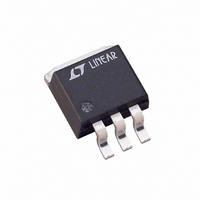LT1585CM#TRPBF Linear Technology, LT1585CM#TRPBF Datasheet - Page 12

LT1585CM#TRPBF
Manufacturer Part Number
LT1585CM#TRPBF
Description
IC LDO REG 4.6A ADJ DDPAK-3
Manufacturer
Linear Technology
Datasheet
1.LT1585CT-3.3.pdf
(16 pages)
Specifications of LT1585CM#TRPBF
Regulator Topology
Positive Adjustable
Voltage - Output
1.25 ~ 5.5 V
Voltage - Input
2.35 ~ 7 V
Voltage - Dropout (typical)
1.2V @ 4A
Number Of Regulators
1
Current - Output
4.6A
Current - Limit (min)
4.1A
Operating Temperature
0°C ~ 125°C
Mounting Type
Surface Mount
Package / Case
TO-263-2, D⊃2Pak (2 leads + Tab), TO-263AB
Lead Free Status / RoHS Status
Lead free / RoHS Compliant
Available stocks
Company
Part Number
Manufacturer
Quantity
Price
APPLICATIONS
LT1584/LT1585/LT1587
For adjustable voltage devices, negative side sensing is a
true Kelvin connection with the bottom of the output divider
returned to the negative side of the load. The best load
regulation is obtained when the top of resistor divider R1
connects directly to the regulator output and not to the
load. Figure 5 illustrates this point. If R1 connects to the
load, the effective resistance between the regulator and the
load is:
R
The connection shown in Figure 5 does not multiply R
the divider ratio. As an example, R
per foot with 16-gauge wire. This translates to 4mV per foot
at 1A load current. At higher load currents, this drop
represents a significant percentage of the overall regula-
tion. It is important to keep the positive lead between the
regulator and the load as short as possible and to use large
wire or PC board traces.
12
P
(1 + R2/R1), R
V
Figure 5. Connection for Best Load Regulation
IN
*CONNECT R1 TO CASE
CONNECT R2 TO LOAD
IN
LT1584
U
ADJ
P
= Parasitic Line Resistance
INFORMATION
OUT
U
LINE RESISTANCE
PARASITIC
P
R2*
R1*
is about four milliohms
R
W
P
LT1584 • F05
U
R
L
P
by
Thermal Considerations
The LT1584/LT1585/LT1587 family protects the device
under overload conditions with internal power and thermal
limiting circuitry. However, for normal continuous load
conditions, do not exceed maximum junction temperature
ratings. It is important to consider all sources of thermal
resistance from junction-to-ambient. These sources in-
clude the junction-to-case resistance, the case-to-heat
sink interface resistance, and the heat sink resistance.
Thermal resistance specifications have been developed to
more accurately reflect device temperature and ensure safe
operating temperatures. The electrical characteristics sec-
tion provides a separate thermal resistance and maximum
junction temperature for both the control circuitry and the
power transistor. Older regulators, with a single junction-
to-case thermal resistance specification, use an average of
the two values provided here and allow excessive junction
temperatures under certain conditions of ambient tem-
perature and heat sink resistance. Calculate the maximum
junction temperature for both sections to ensure that both
thermal limits are met.
Junction-to-case thermal resistance is specified from the
IC junction to the bottom of the case directly below the die.
This is the lowest resistance path for heat flow. Proper
mounting ensures the best thermal flow from this area of
the package to the heat sink. Linear Technology strongly
recommends thermal compound at the case-to-heat sink
interface. Use a thermally conductive spacer if the case of
the device must be electrically isolated and include its
158457a








